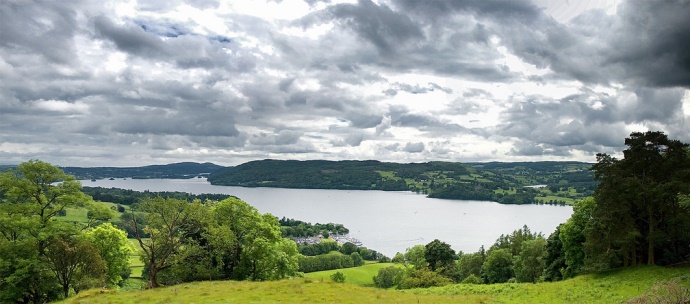From Jane Eyre to Sherlock Holmes, Britain’s literary history is a rich one. We’ve rounded up some of the top spots in the UK to discover the realms of Jane Austen, William Shakespeare, the Brontë sisters, Dylan Thomas and many other literary greats.
Windermere, the Lake District – Beatrix Potter
With the proceedings from her first book and greatest success, The Tale of Peter Rabbit, in 1905 Beatrix Potter bought Hill Top Farm, a farm house in Near Sawrey, a small village in the English Lake District near Windermere. She used Hill Top and the surrounding countryside as inspiration for many of her subsequent books. When Potter died in 1943 at age 77, she left almost all her property to the National Trust. Potter is credited with preserving much of the land that now comprises the Lake District National Park.
Pick up the Literary Vibe: Beatrix Potter’s 17th-century farmhouse, Hill Top is an authentic time-capsule of her life. Full of her favourite things, this house appears as if Potter had just stepped out for a walk. Every room contains a reference to a picture in a ‘tale’.
Where to Stay: Check our Windermere Hotels for the best deals.
Stratford-upon-Avon, Warwickshire – William Shakespeare
A major literary pilgrimage site, Stratford-upon-Avon is after all the birthplace of Britain’s most famous bard. This small market town aggregates many literary attractions such as the renowned Royal Shakespeare Theatre, Shakespeare’s last home, New Place, his wife Anne Hathaway’s cottage or the museum Nash’s House.
Pick up the literary vibe: The many Tudor styled buildings of the town take you back in time and a visit to the Royal Shakespeare Theatre is an absolute must if you’re a Shakespeare fan.
Where to stay: Click here for Stratford-upon-Avon hotels.
Bath, Somerset – Jane Austen
Follow in Austen’s footsteps by discovering the beautiful city of Bath, where the novelist lived between 1801 and 1806. The architecture of the city served as an inspiration for most of her novels, and today remains hardly unchanged from the streets depicted in Northanger Abbey or Persuasion. When in town you can also visit the Jane Austen Centre, which is set in a Georgian town house, next door from where Jane actually lived.
Pick up the literary vibe: Once you’ve learned about Austen’s life at the centre, just head upstairs to the Regency Tea Rooms where you can enjoy an afternoon high-tea in a real life Georgian setting. Finalise your literary tour by stopping at a souvenir shop to pick up an ‘I Love Darcy’ t-shirt!
Where to stay: Click here for our selection of Bath hotels.
Swansea and Carmarthenshire, Wales – Dylan Thomas
Wales’ most famous literary character Dylan Thomas referred to Carmarthenshire as the ‘fields of praise’, which so inspired his writings. Born in Swansea, Thomas’ childhood was spent mostly in Carmarthenshire, and it is in Laugharne, “The strangest town in Wales”, where he is encouraged to write some of his greatest works including Under Milk Wood and Fern Hill. The town is now enjoying a resurgence of interest brought on by the success of the film The Edge of Love, starting Keira Knightley, Sienna Miller and Matthew Rhys, and which tells the story of the Welsh writer through the eyes of the two women he loves.
Pick up the Literary Vibe: Visit Laugharne, where you’ll find Dylan’s shed-cum-study the Boathouse (“My seashaken house / On a breakneck of rocks”) where he wrote many of his works.
Where to stay: The Great National Hotel in Swansea is located next to Train Station in the heart of Swansea City Centre.
Lewes, East Sussex – Virginia Woolf
Although a significant figure in literary London, Virginia Woolf’s life and career is predominantly connected to the village of Rodmell, south east of Lewes in East Sussex. Here the writer and her husband, the political activist Leonard Woolf, bought a 17th century cottage known as Monk’s House. It was here that many of her novels were written, including Mrs Dalloway (1925). The couple also hosted here many important visitors connected to the Bloomsbury Group, an influential group of associated English writers, intellectuals, philosophers and artists including T.S. Eliot among others. Virginia documented most of her life at Monk’s House in photographs, including portraits and group pictures of many who visited the house.
Pick up the literary vibe: Monk’s house was eventually turned over to the National Trust in 1980 and is open to the public. The ground floor, including sitting room, dining room, kitchen and Virginia’s bedroom, is on display and Virginia’s writing lodge can be found at the bottom of the garden with views across to Mount Caburn.
Where to stay: Check our hotels in Lewes.
London, England –John Keats
Most of the poet’s brief life was spent in London, where he was born in 1795 in a livery stable in Moorgate run by his father. He moved to Hampstead in 1817 and met his fiancée, Fanny Brawne, there. He later left for Rome in 1820 and died there a year later.
Pick up the Literary Vibe: You can visit the home of poet John Keats in Hampstead, London where he lived from 1818 to 1820. This was the setting that inspired most of Keats’ memorable poetry, like Ode to a Nightingale, which he wrote while sitting under a plum tree in the garden.
Where to stay: Click here for London hotels.
Oxford, Oxfordshire –JRR Tolkien and CS Lewis
Oxford has produced famous high achievers in English literature. Quite a few household names were Oxford students and academics. JRR Tolkien spent most of his adult life there – first as a professor of Anglo Saxon at Pembroke College and later as a professor of English Literature at Merton College. He wrote The Hobbit while at Pembroke. C.S. Lewis, who spent time with Tolkien in The Inklings, an Oxford writers’ group, also had a strong attachment to Oxford. He was a Fellow and Tutor in English at Magdalen College, Oxford for 29 years and though he moved to Cambridge in 1954, he maintained a house in Oxford all his life.
Charles Dodgson (aka) Lewis Carroll, Oscar Wilde, W.H. Auden, William Golding (Lord of the Flies), and many more studied, taught or lived in Oxford.
Pick up the literary vibe: Visit one of Oxford’s most famed literary pubs, The Eagle and Child on St. Giles, called by Tolkien and others “The Bird and Baby,” this was the meeting place of The Inklings, the literary discussion group favoured by Tolkien and C.S. Lewis.
Where to stay: The Hawkwell House Hotel in Oxford is a quintessential country house, just a short drive from the centre of Oxford.
Portsmouth, Hampshire – Charles Dickens
Charles Dickens was born in Portsmouth, Dorset in 1812 – the first married home of his parents, John and Elizabeth Dickens. Much of Victorian Portsmouth still remains in the city’s streets and heritage today, drawn upon by Dickens himself in his third novel Nicholas Nickleby.
Pick up the literary vibe: The Charles Dickens Birthplace Museum is the perfect place to start exploring and experiencing the work of one of England’s most famous and best-loved writers.
Where to stay: Check HotelREZ’s member hotels in Portsmouth.
Edinburgh, Scotland – Arthur Conan Doyle
Sir Arthur Conan Doyle was a Scottish physician and novelist born in Edinburgh, and of course most renowned for being the author of the crime genre classic Sherlock Holmes. Even though Conan Doyle left the city later in his life for England and then Vienna, some believe most of his work was influenced by the Scottish capital. His most famous character Sherlock Holmes was based on an individual he met at the Royal College of Surgeons, and the Salisbury Crags, a prominent landmark on the cityscape, were apparently a backdrop for The Lost World.
Pick up the Literary Vibe: Take a literary pub tour of the city where professional actors take you across three hundred years of great writing in the city. And don’t miss the bronze statue of Sir Arthur Conan Doyle which stands in Picardy Place.
Where to stay: Tour the city by day and retire to the outskirts of Edinburgh for some peace and relaxation at The Lodge at Craigielaw Golf Course, only 35 minutes away from the centre of Edinburgh.
Image Credits:
Shakespeare’s first folio by Caro Wallis via Flickr (CC BY-NC-ND 2.0)
Annual Jane Austen Festival, Bath image by Owen Benson via Flickr (CC BY-NC 2.0)
Dylan Thomas train image by Alex Drennan via Flickr (CC BY-NC-ND 2.0)
The eagle and child, Oxford by Graham Higgs via Flickr (CC BY-ND 2.0)
Top Withens image by Tom Green via Flickr (CC BY 2.0)
Windermere lake image by Mark © Blue Boy ®TBB via Flickr (CC BY-NC-SA 2.0)
Laugharne castle image by rach2k via Flickr (CC BY-NC-SA 2.0)
Oxford image by Jose Maria Cuellar via Flickr (CC BY-NC 2.0)













